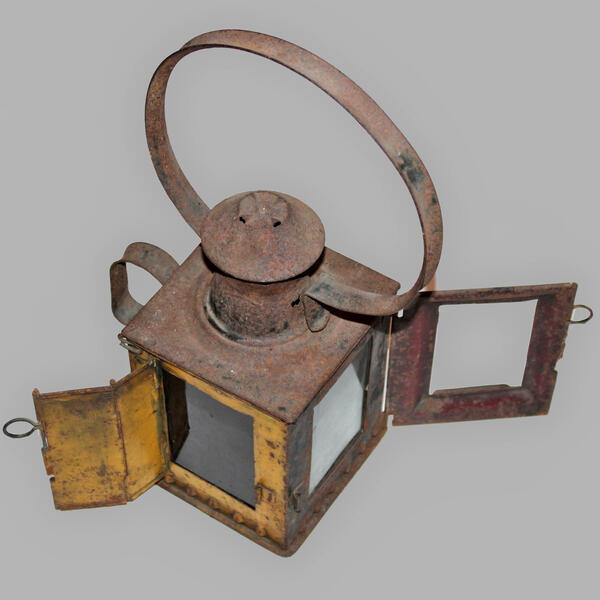This is a rectangular railroad candle lamp, manufactured between the mid-1930s and late 1950s. The exhibit is an original light fixture that was used for its intended purpose on railroads, in passenger cars, as well as in the so-called teplushkas, which were former freight cars that had been thermally insulated and repurposed for the transportation of passengers.
The lamp has a metal steel frame fitted with glass windows. It used a paraffin candle as the light source and had a reflector that was installed behind the candle to scatter its light, expanding the lamp’s coverage area. The front side of the lamp has a hinged lid used to replace the candle. Lamps like these are very easy to use and have not grown completely obsolete even today.
The odds are, this lantern witnessed the creation and development of IshimbAevo’s railroad station. In the early 1930s, the leadership of the Republic of Bashkortostan was faced with the need to build a railroad to the village of IshimbAevo (Ishimbay would not become a city until 1940). The problem was urgent, as a high-capacity transport system was necessary both for transporting the obtained oil and for delivering equipment and construction materials needed for further development of oil production. On July 5, 1933, the Council of Labor and Defense of the Soviet Union adopted a special resolution on the construction of a railroad line to BashkIr sources of oil.
To speed up the construction, it was decided to begin without submitting receipts, drawing up a project, or even estimating the budget. The Soyuztransstroy trust company under the People’s Commissariat of Heavy Industry carried out the construction and was provided with everything necessary for the project. Additionally, much help came from peasants: the collective farmers of Arkhangelsky, Karmaskalinsky, Sterlitamaksky, Makarovsky, Ufimsky, and other districts of Bashkortostan worked towards the supply of timber for bridges, sleepers, and stations; carried out earthworks; and took part in the construction of an embankment. Many local industrial construction companies contributed to the creation of the railroad line as well.
As a result, the 177-kilometer-long railroad line was built in under a year. The first train with tank cars arrived at Ishimbaevo on September 30, 1934. The line was put into normal operation at the end of 1935 and was accepted by the People’s Commissariat of Railways of the Soviet Union in March 1936.
The lamp has a metal steel frame fitted with glass windows. It used a paraffin candle as the light source and had a reflector that was installed behind the candle to scatter its light, expanding the lamp’s coverage area. The front side of the lamp has a hinged lid used to replace the candle. Lamps like these are very easy to use and have not grown completely obsolete even today.
The odds are, this lantern witnessed the creation and development of IshimbAevo’s railroad station. In the early 1930s, the leadership of the Republic of Bashkortostan was faced with the need to build a railroad to the village of IshimbAevo (Ishimbay would not become a city until 1940). The problem was urgent, as a high-capacity transport system was necessary both for transporting the obtained oil and for delivering equipment and construction materials needed for further development of oil production. On July 5, 1933, the Council of Labor and Defense of the Soviet Union adopted a special resolution on the construction of a railroad line to BashkIr sources of oil.
To speed up the construction, it was decided to begin without submitting receipts, drawing up a project, or even estimating the budget. The Soyuztransstroy trust company under the People’s Commissariat of Heavy Industry carried out the construction and was provided with everything necessary for the project. Additionally, much help came from peasants: the collective farmers of Arkhangelsky, Karmaskalinsky, Sterlitamaksky, Makarovsky, Ufimsky, and other districts of Bashkortostan worked towards the supply of timber for bridges, sleepers, and stations; carried out earthworks; and took part in the construction of an embankment. Many local industrial construction companies contributed to the creation of the railroad line as well.
As a result, the 177-kilometer-long railroad line was built in under a year. The first train with tank cars arrived at Ishimbaevo on September 30, 1934. The line was put into normal operation at the end of 1935 and was accepted by the People’s Commissariat of Railways of the Soviet Union in March 1936.



